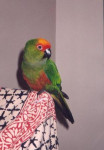Welcome to the
Gold-Capped Page!
|
Name: Chico
|
Name: Rocco |
|
Name: Golden-Capped Conure (Aratinga Auricapilla)
Description: General plumage is a dark green with the top of their forehead and eye area red, and their forecrown an orange-yellow. The cheeks in some birds are a pale yellow to orange-yellow. The throat and upper breast is tinged a faintly greyish-blue. The feathers on the lower breast, abdomen, and lower back are edged in burgundy-red. Under wing-coverts are red with the outer webs of primaries, primary-coverts, and secondaries blue. The upperside of the tail is an olive-green with blue tips and the underside of the tail and flight-feathers are black. The Periophthalmic Ring is whitish and the Iris is brown. Their beak is black and their feet are grey. Average length is 30 cm (12 inches). Immatures have a green fore-crown with a scattering of a few red to orange-red feathers. Also have a red edging to abdomen and the lower back is fainter. Iris dark. All Conures are not sexually dimorphic and must be DNA or surgically sexed.**
In The Wild: They are usually observed in pairs or in small groups of 4 to 10 birds. They are difficult to detect in trees since they are well camouflaged by their plumage. They are rare and endangered and have already disappeared from many areas because of extensive deforestation.
Breeding Information: Breeding usually begins in the spring, but is also possible in the winter. (Several breedings a year are possible.) An average clutch is 3 to 5 eggs with an incubation period of 23 days and a fledging period of 50 days. Their eggs measure 30.4 x 23.5 mm (1.20 x 0.93 inches).
Temperament: As with most of the Aratinga species of Conure they are fairly loud to noisy. They are hardy and not very difficult to keep. They are noisy most often in the early morning and evening as well as when alarmed. Soon becomes accustomed to their owner. They are hard chewers and a regular supply of fresh twigs is recommended. Enjoys bathing as well.**
Diet: This should consist of Pellets, a good Seed Mix (Safflower, Oats, some Sunflower--also sprouted--Hemp, Wheat, Canary Grass Seed and various Millets), with lots of Fruits and Vegetables. White bread and eggfood for rearing. Diets may vary so you should consult your Avian Veterinarian.
* (Information Unavailable.)
** (Please note that not all birds are the same and may vary somewhat in Temperament and Plumage.)
Created by Rio
Designs
Champaign, Illinois

